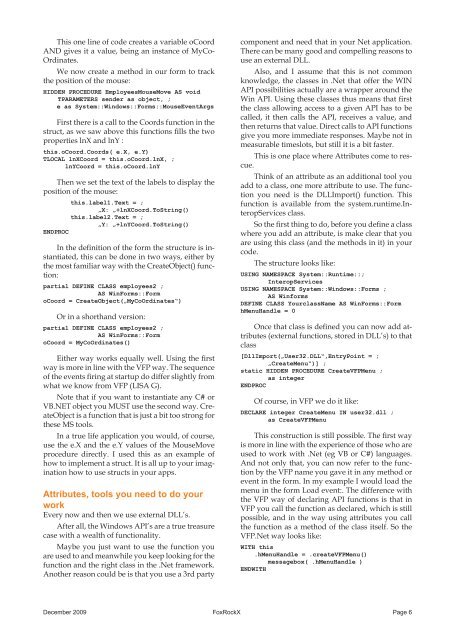Create successful ePaper yourself
Turn your PDF publications into a flip-book with our unique Google optimized e-Paper software.
This one line of code creates a variable oCoord<br />
AND gives it a value, being an instance of MyCo-<br />
Ordinates.<br />
We now create a method in our form to track<br />
the position of the mouse:<br />
HIDDEN PROCEDURE EmployeesMouseMove AS void<br />
TPARAMETERS sender as object, ;<br />
e as System::Windows::Forms::MouseEventArgs<br />
First there is a call to the Coords function in the<br />
struct, as we saw above this functions fills the two<br />
properties lnX and lnY :<br />
this.oCoord.Coords( e.X, e.Y)<br />
TLOCAL lnXCoord = this.oCoord.lnX, ;<br />
lnYCoord = this.oCoord.lnY<br />
Then we set the text of the labels to display the<br />
position of the mouse:<br />
this.label1.Text = ;<br />
„X: „+lnXCoord.ToString()<br />
this.label2.Text = ;<br />
„Y: „+lnYCoord.ToString()<br />
ENDPROC<br />
In the definition of the form the structure is instantiated,<br />
this can be done in two ways, either by<br />
the most familiar way with the CreateObject() function:<br />
partial DEFINE CLASS employees2 ;<br />
AS WinForms::Form<br />
oCoord = CreateObject(„MyCoOrdinates“)<br />
Or in a shorthand version:<br />
partial DEFINE CLASS employees2 ;<br />
AS WinForms::Form<br />
oCoord = MyCoOrdinates()<br />
Either way works equally well. Using the first<br />
way is more in line with the VFP way. The sequence<br />
of the events firing at startup do differ slightly from<br />
what we know from VFP (LISA G).<br />
Note that if you want to instantiate any C# or<br />
VB.NET object you MUST use the second way. CreateObject<br />
is a function that is just a bit too strong for<br />
these MS tools.<br />
In a true life application you would, of course,<br />
use the e.X and the e.Y values of the MouseMove<br />
procedure directly. I used this as an example of<br />
how to implement a struct. It is all up to your imagination<br />
how to use structs in your apps.<br />
Attributes, tools you need to do your<br />
work<br />
Every now and then we use external DLL’s.<br />
After all, the Windows API’s are a true treasure<br />
case with a wealth of functionality.<br />
Maybe you just want to use the function you<br />
are used to and meanwhile you keep looking for the<br />
function and the right class in the .Net framework.<br />
Another reason could be is that you use a 3rd party<br />
component and need that in your Net application.<br />
There can be many good and compelling reasons to<br />
use an external DLL.<br />
Also, and I assume that this is not common<br />
knowledge, the classes in .Net that offer the WIN<br />
API possibilities actually are a wrapper around the<br />
Win API. Using these classes thus means that first<br />
the class allowing access to a given API has to be<br />
called, it then calls the API, receives a value, and<br />
then returns that value. Direct calls to API functions<br />
give you more immediate responses. Maybe not in<br />
measurable timeslots, but still it is a bit faster.<br />
This is one place where Attributes come to rescue.<br />
Think of an attribute as an additional tool you<br />
add to a class, one more attribute to use. The function<br />
you need is the DLLImport() function. This<br />
function is available from the system.runtime.InteropServices<br />
class.<br />
So the first thing to do, before you define a class<br />
where you add an attribute, is make clear that you<br />
are using this class (and the methods in it) in your<br />
code.<br />
The structure looks like:<br />
USING NAMESPACE System::Runtime::;<br />
InteropServices<br />
USING NAMESPACE System::Windows::Forms ;<br />
AS Winforms<br />
DEFINE CLASS YourclassName AS WinForms::Form<br />
hMenuHandle = 0<br />
Once that class is defined you can now add attributes<br />
(external functions, stored in DLL’s) to that<br />
class<br />
[DllImport(„User32.DLL“,EntryPoint = ;<br />
„CreateMenu“)] ;<br />
static HIDDEN PROCEDURE CreateVFPMenu ;<br />
as integer<br />
ENDPROC<br />
Of course, in VFP we do it like:<br />
DECLARE integer CreateMenu IN user32.dll ;<br />
as CreateVFPMenu<br />
This construction is still possible. The first way<br />
is more in line with the experience of those who are<br />
used to work with .Net (eg VB or C#) languages.<br />
And not only that, you can now refer to the function<br />
by the VFP name you gave it in any method or<br />
event in the form. In my example I would load the<br />
menu in the form Load event:. The difference with<br />
the VFP way of declaring API functions is that in<br />
VFP you call the function as declared, which is still<br />
possible, and in the way using attributes you call<br />
the function as a method of the class itself. So the<br />
VFP.Net way looks like:<br />
WITH this<br />
.hMenuHandle = .createVFPMenu()<br />
messagebox( .hMenuHandle )<br />
ENDWITH<br />
December 2009 FoxRockX Page 6
















